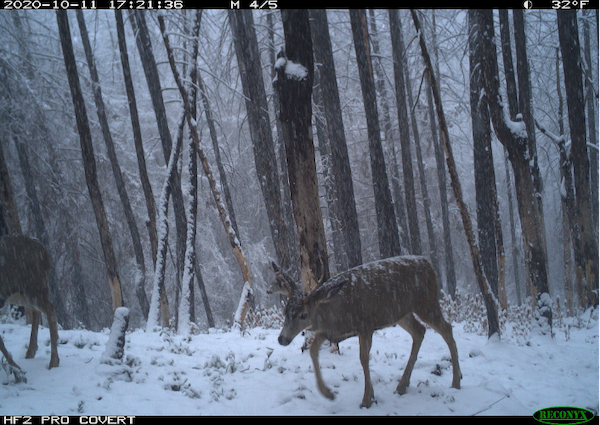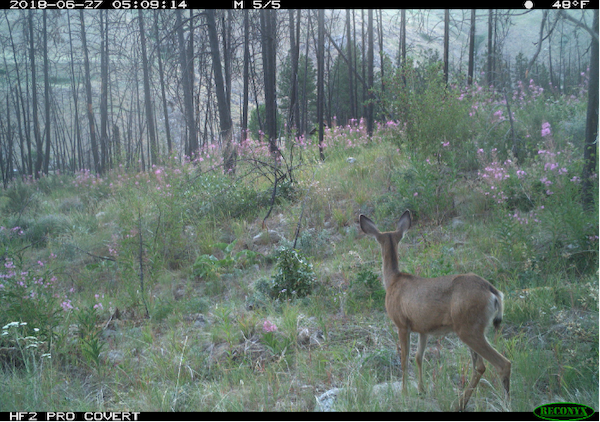
WA Deer Hunters Surveyed; Okanogan Predator-Prey Research Out
As I put together my Washington fall buck hunting prospects for this year’s seasons, there were a couple deer-related things that I couldn’t quite jam into that nearly 6,000-word tome.
Over the summer, WDFW posted the 2022 Washington Hunters’ Attitudes Toward Wildlife and Hunting Management report, while earlier this month an intriguing paper titled “Interactive effects of wildfires, season and predator activity shape mule deer movements” came out of the Predator-Prey Project.

Both are enlightening in their own way, yielding insights into the mindset of Evergreen State riflemen, archers and muzzleloaders over the short and longer term, and how mule deer, wolves and cougars are navigating Northcentral Washington’s wildfire-singed landscapes, one of the state’s premier buck hunting areas.
Highlights from Responsive Management’s survey, performed via telephone and online in June and July, found that 75 percent of the 1,154 hunters surveyed identified as deer hunters, 44 percent chased elk, 29 percent waterfowl, 25 percent small game, 23 percent bear, 22 percent migratory birds and 13 percent cougars.
Last year, 78 percent of deer hunters used a rifle, 17 percent a bow and 12 percent a muzzleloader.
(Overall, the average Washington sportsman was 51.44 years old and had hunted for 25.9 years (the survey excluded hunters younger than 16). Eighty-three percent were white, 4 percent were Native American or Alaskan native, 3 percent were Hispanic, and black, East Asian and South Asian hunters each tallied 1 percent.
Twelve percent lived in King County, 10.6 percent in Spokane County, 9.9 in Pierce County and 8.5 in Snohomish County, the state’s most populous counties, but 28 percent consider their actual residence to be rural (but not a farm or ranch), 25 percent a small city or town, 20 percent a suburban area, 14 percent a large city or urban area and 12 percent a ranch or farm.)
Ninety percent of all hunters reported hunting on public land in the previous three seasons, with 66 percent saying they’d done so on U.S. Forest Service ground.
Speaking of, the northern Okanogan-Wenatchee National Forest was host to the aforementioned work done for the Predator-Prey Project – a joint research project of the Washington Department of Fish and Wildlife and the University of Washington. It involved capturing and collaring 150 Methow Valley mule deer does, as well as a number of local cougars and wolves, and then matching GPS data with wildfire mapping to develop a better understanding of how the animals used burned areas through the year.
According to lead author Taylor Ganz, a UW Ph.D. student, some 40 percent of Okanogan County has burned since 1985, and much of that has occurred in upper valley lands around Winthrop and Twisp via the Farewell, Fawn Peak, Tripod, Carlton Complex, Cedar Creek and Cub Creek II, among other wildfires.
It’s been a boon for deer, creating plentiful, rich forage and at all elevations, and Ganz et al note that muleys really do key in on burned areas in summer.
The other good news if you’re a deer is that those areas – with their fallen trees and tangles of branches and willows – also generally provide protection from wolves as they recolonize the region. Wolves are born to chase their prey, preferably over landscapes with few hurdles, and so burn scars act as something of a refuge for deer from the long-legged lopers. The researchers found “deer increased use of burned areas when and where wolf activity was high.”

However, the same conditions that grade against wolves running rampant work quite well, thank you very much, for cougars to ambush deer. Where the big cats were most active, deer tended to stay away.
And where deer were overall attracted to regenerating burns in the high season, come winter, they tended to avoid them, Ganz and crew found. Without needled-out tree limbs to intercept falling white stuff, it piles up and up and up, 1) blocking deer access to forage and 2) making them much more vulnerable to predation because they can get caught in the deep snow. They especially “avoided burns when and where cougar use was high in winter,” the researchers stated.
For a deer hunter who has spent more than a little time gazing at the Okanogan’s terrain, burned and unburned, and wondered how building wolf numbers will affect the herd, it all kind of makes intuitive sense. The same deadfalls and underbrush that keep me from moving very fast (and, needless to say, very quietly) work against wolves, but more than once the hair on the back of my neck has wanted to stand up as I’ve waded into them.
Ganz reports that how muleys related to cougars lurking in burned areas was also dependent on how hot the woods had burned and how long it had been since fire swept through, but overall the deer were able to manage the risk and reward of foraging there.
“We did not find that deer were any more likely to die in a burned area versus an unburned area. In other words, their movement response and other antipredator behaviors are adequate to balance changes in predation risk associated with burns,” Ganz also told me.
Speaking of predators, they are Washington deer hunters’ top concern, according to the Responsive Management survey, with 26 percent calling wolves, cougars, bears, coyotes and other furry fangers the most important issue facing the state’s mule deer, whitetail and blacktail.
Close behind was habitat loss, 24 percent, followed distantly by disease/herd health at 14 percent.
(Elk hunters felt similarly, with 30 percent saying predators were the most important factor, followed by disease/health at 22 percent, habitat loss at 17 percent and management 12 percent.)
Ganz and fellow researchers report 52 of their collared Methow deer died during the study, and 22 of those were confirmed to have died at the claws and teeth of predators, with another nine dying from an unknown cause but likely predation. Of the confirmed deaths, 15 were attributed to cougars, three to coyotes, one to bears and one to wolves.
That last one surprised and didn’t surprise me. As Ganz pointed out, there just weren’t a lot of wolves on the landscape during the study.
“Based on WDFW estimates, there may have been as few as 10-15 wolves in the study region, which is just not that many relative to the amount of deer out there,” she told me. “As you mention, moose, white-tailed deer, and other critters contribute to wolf diets (and even grasses and berries – wolves are omnivorous). That’s one reason we don’t have many documented wolf mortalities.”

But she cautioned that there was also a fair percentage of deaths by unknown causes and pointed to difficulties reaching carcasses after collars give off mortality signals.
“That doesn’t mean that it wasn’t predation, just that we don’t know how they died. Some of these could have been from predation. Sounds like you know how rough that country is, and when a deer dies far back in the wilderness, it can take some time for us to get there to investigate, not to mention complications from washed-out roads, avalanche conditions, etc. Sometimes the GPS collars malfunction, too – another delay in getting to the mortality site (an issue in all collaring studies). These factors contribute to the high number of unknown mortalities,” Ganz stated.
She also suspects that some causes of death are just easier to confirm than others.
“For instance, because cougars cache their prey, it tends to be pretty easy to find a tidy mortality scene and determine who was responsible. On the other hand, a pack of wolves can consume a deer in a single feeding bout AND widely disperse the carcass, which makes it very difficult to identify the cause. It would be nearly impossible to distinguish that evidence from a deer that died of disease, say, and was dispersed by scavengers. Our genetic methods help, but there’s still a lot unknown about such sites,” Ganz added.
So what are Okanogan wolves eating? She says that another UW Ph.D candidate, Lauren Satterfield, has been looking into wolf diets and will be analyzing what’s on the menu.
Needless to say, I eagerly await a chance to chew on that information.

As for some other results from the hunter survey, WDFW’s management of deer “was not rated very well,” with two-thirds of deer hunters putting it in the “bottom half of the scale (35 percent fair; 28 percent poor)” and one-third in the top half (6 percent excellent, 25 percent good).
“Lower ratings were often the result of hunters’ disagreement with management decisions,” Responsive Management stated.
Some hunters want WDFW to return to a four-point minimum for Northeast Washington whitetails, while others would like later seasons better timed to the rut. Recent years have also seen antlerless opportunities sharply cut back for all user groups, even youths – but to help rebuild disease-stricken herds.
A slim plurality of hunters were more satisfied than dissatisfied (47 to 40 percent) with their 2021 deer season, which saw the lowest general season harvest of the millennium. Twenty-eight percent reported tagging out. (WDFW’s harvest report shows a 24 percent statewide success percentage.)
In a question that crosses into predator-prey research territory, the survey gave mule deer hunters three options for increasing their success and decreasing hunter density. A split season – early or late – found support from 30 percent, an Oregon-style controlled-hunt-only season 14 percent, and a mule deer-, blacktail- or whitetail-only license 10 percent. Of note, the largest cohort, 32 percent, chose none of the three ideas. Muleys are a general rifle season in Eastern Washington, with a three-point minimum everywhere .
The survey also provided a glimpse of long-term trends, though Responsive Management advised the results “should be interpreted cautiously” due to a pair of methodology changes that included use of an online survey in addition to telephone, as used in 2007 and 2014.
Where the 2014 survey saw 56 percent of hunters “very satisfied” coming out of the 2013 season (overall success rate: 28 percent), the latest found 18 percent of online and 44 percent of telephone surveyees rated 2021’s hunt that highly. Where 18 percent were “somewhat satisfied” in 2014, 29 percent of online and 31 percent of telephone respondents were in 2022. And where 11 percent were “very dissatisfied” eight years ago, 21 and 20 percent, respectively, were this year.
The survey did record slight shifts over time in terms of weapons type used, with rifle declining from 80 percent in 2007 to 78 in both 2014 and 2022, archery growing from 16 to 18 to 19 percent and muzzleloader also increasing from 8 to 11 to 12 percent. Shotgun use has also ticked up, from 5 percent in 2007 to 6 percent in both 2014 and 2022.
And while the combination of phone and online surveying makes comparing 2022 to 2007 and 2014 reports difficult, in general, the proportion of hunters who rate WDFW deer management as good has declined from 2007, while those giving the agency a fair rating has increased.
“WDFW staff are reviewing these results, similarly to the other survey (of state residents on hunting). We intend to use the results of this survey to inform some sections of the game management plans, where applicable,” stated agency spokeswoman Samantha Montgomery.
And that, on a Friday afternoon that I probably should have been doing Other Work after having skipped out to go coho fishing this morning, is going to have to be all I say about that.

